The Shops of Woburn Sands
This is a work-in-progress of a list of the buildings used as commercial premises in Woburn Sands.
The individual buildings were only numbered under a Post Office scheme in about 1935; before this, most references just gave “The High Street” as the full address and postmen and messengers had to know where every business was. Many of the details here come from the late Arthur Parker’s work, but there is a significant gap between that ending in c.1980 and my own memories starting. The late Dolly Mills’ memories are also included.
If you have any memories of owning, working in, or using any of these local shops, or can add any new ones, please contact me.
Where dates are quoted, this may be only an indication of when a certain business was definitely there and does not represent their entire tenure.
I have illustrated the text where I can from my own collection. Images marked WSDS are from the collection of the Woburn Sands District Society. Ampthillimages.com have also generously contributed images.
High Street, East Side
No. 1 – James Harbert was a local lace dealer who pulled down the old cottages on this site, and built these premises sometime between 1820 and 1830. The original building has been much extended over the years. James died in 1854, leaving his property to his daughter, Hannah, who continued in the house until she died in 1903, when the property, along with many others in The Square, were sold to the adjoining owner, Thomas Hudson. He was a butcher and Woburn Sands’ first postmaster. He converted the building to business premises, and it became a grocer’s shop, with the first tenant being J. W. Tansley (1903 – 1920).
Leslie Leigh Lancaster bought the premises in 1920. He was a first-class bootmaker, having had shops in London’s West End before he came here in the early days of the First World War, to set up business at No. 26 Aspley Hill. Soon after his transfer to The Square, whilst still retaining the footwear business, but envisaging the coming era of road transport, he set up a bus service between here and Bletchley, which ran in the evening, especially for the Cinema. This small beginning was soon enlarged, and he ran coaches to the seaside on Sundays, and anywhere else, when required. Some of this business was eventually sold to a Bedford firm, while the cinema runs were taken by another local firm, Armstrong’s.
The Second World War brought further enterprise, when one end of the shop was rented out as a chemist (Wynn’s Pharmacy). This passed through two or three hands and then reverted to the Lancaster family, who completely remodelled the premises, and the whole ground floor stocked a wide range of clothes, haberdashery, gifts and toys. It was then run by Leslie’s two daughters. The righthand side (1a) was later separated off and became the home for Pete Lowe’s butchers (Veronica Leigh Lancaster’s son-in-law) when they moved around from Aspley Hill in 1984 and traded there till 2012. After trading as White & McLeod cards and gifts for a couple of years, it is now (2023) Shelley Hanson Gift & Homeware, in conjunction with the Flower Boutique, who moved up from No.45.
When the Lancaster ladies had retired, the lefthand side (1b) became Coversure Insurance in 1998, then Lords Estate Agent, followed by O’Riorden Bond in the same trade. It was then Blue Damson gardenware in 2010, before opening in 2011 as Eva’s clothing shop. This transferred down the street to no. 21 in late 2012 and a travel agency, “Experience the World”, took up residence.
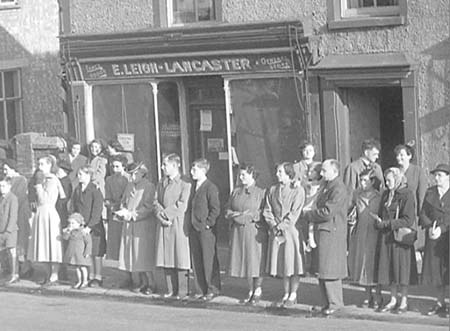
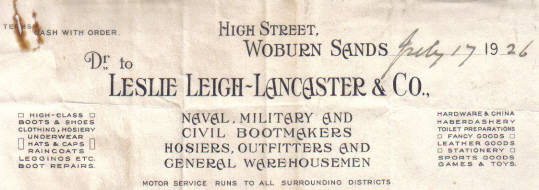
No. 3 – This is the alleyway beside No.1 where the Lancaster’s Coaches were run from. White on Blue Photography now operate from here.
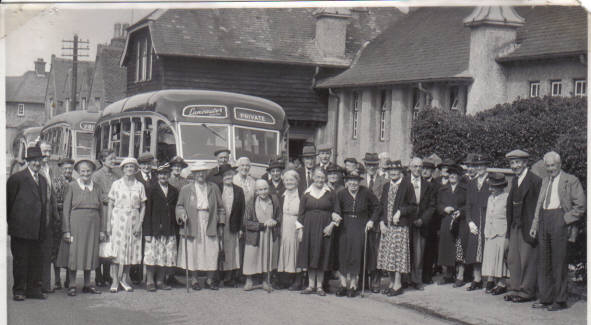
No. 5 – This land had been purchased in 1905 by Fisher, the Woburn printer, but he did not build on it. It is said the remaining part was purchased by Alfred Allnutt of Edgbury to build a daughter-church, or hall, but again, nothing was done, so when the Edgbury estate was broken up in 1921, Barclays purchased the land for a bank. This too fell through, and it wasn’t until 1928 that the whole was acquired by Frederick Summerford, the Salford builder, who erected the furniture shop established by Joseph W. Smith. It was Weatherhead’s, the electrical retailer and service centre (c.1960 – 2005) who had moved around the corner from no.2 Aspley Hill, then used by Biker Den, a motorbike accessories shop (2006 – 2008), who had also moved around from Aspley Hill. From 2006 to 2012, it was Woburn Zens Chinese restaurant and after a lengthy planning debate, Tesco opened a supermarket here.
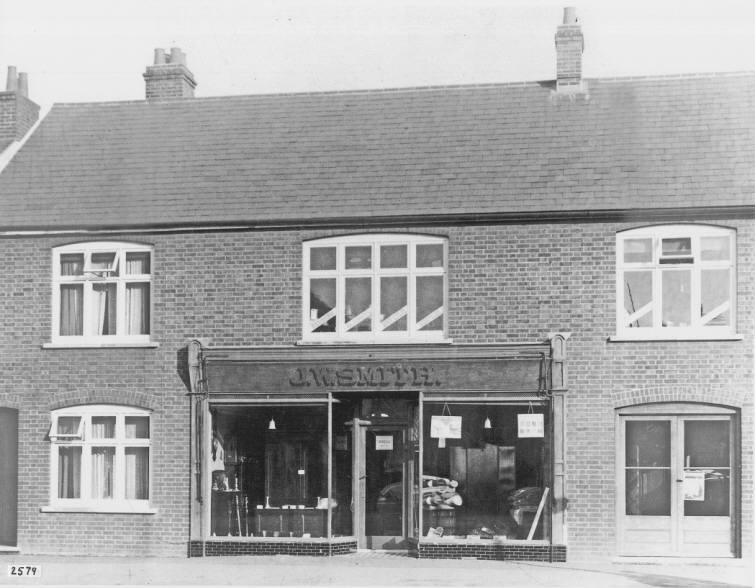
No. 7 – The building was erected on the edge of Swan Field, which was part of the Swan Farm originally opposite. When Downham Road was laid out and plots sold, the corner plots facing the High Street sold in 1906, earlier than the rest. No.7 became the grocery shop of the old Woburn Sands Co-Operative Society. It passed from the Co-op to J. W. Tansley, who had moved from No. 1 and later his widow was followed by Arthur Markwell and then his son, Ernest, who retired and sold to Mr. Payne. Later it belonged to D. L. Trask, another grocer. In the mid 1970s, it was a delicatessen under Peter and Sheila Knight, later selling fabric under Ken and Marjory Alston, but by 1998 was Jephson’s Solicitors. It was then a travel agency which changed hands from Gemini Leisure back to an earlier tenant, the Co-op. It opened as “Seven”, a ladies clothes and accessories shop, in 2012.
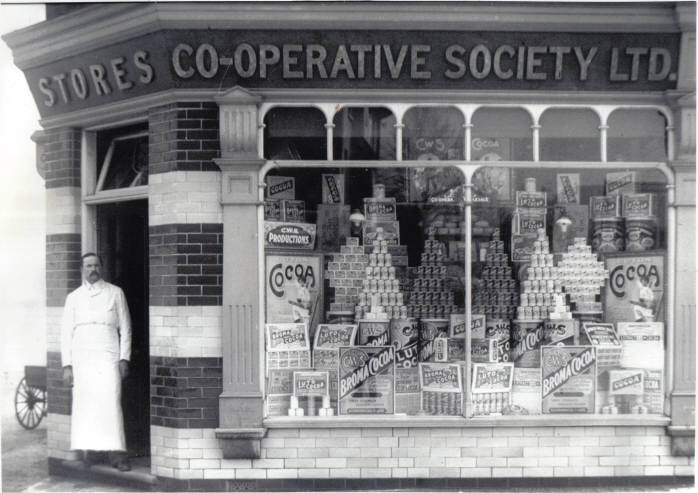
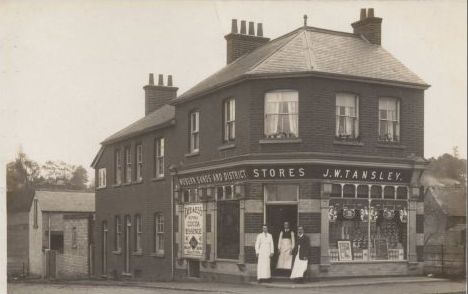
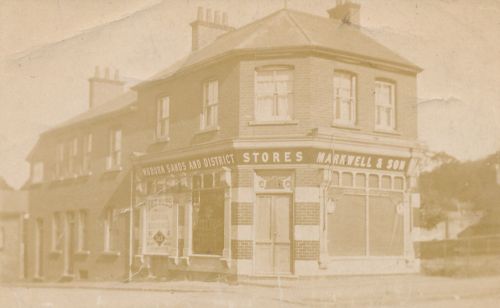
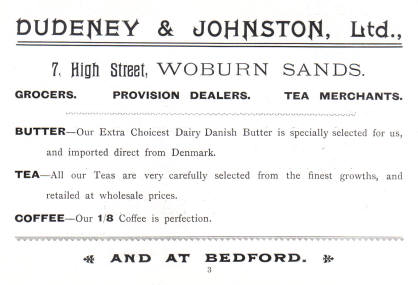
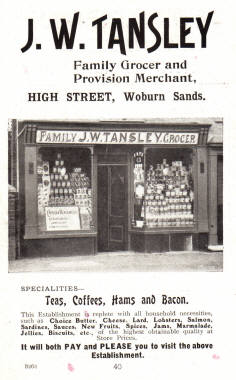
Next comes the entrance to Downham Road.
No. 9 – On the other side of Downham Road, James McMurtrie built his commanding furniture store in 1906 from plans drawn-up by a Mr. Grover. McMurtrie held the shop until his death in 1953, when the local firm Foll and Parker purchased it for Estate Agent offices. They held it at least until 1965 when they were amalgamated with Brown & Merry, with John Foll becoming a partner. It remains as Brown & Merry today.
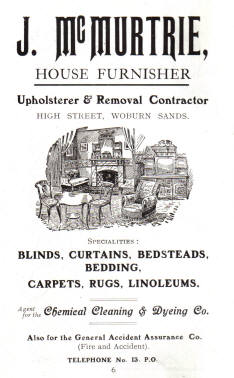
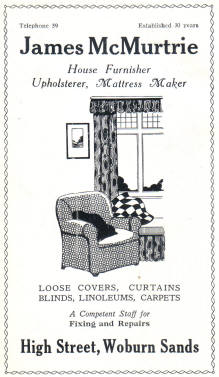
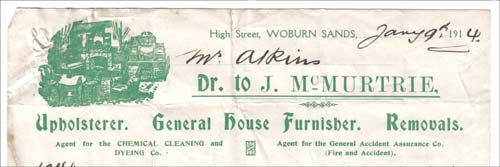
There is a jump in numbers covering the Pikesley Garage area.
The garage site has been such since the High Street first was built on. As you will see under No.29, the Pikesley name was originally connected to the Post Office and undertakers, I am unsure of when they moved into the garage business. In the 1950’s, it changed to R. W. Harris & Son for a while before reverting to Pikesley. After many years selling Esso petrol, the current offering is Texaco.
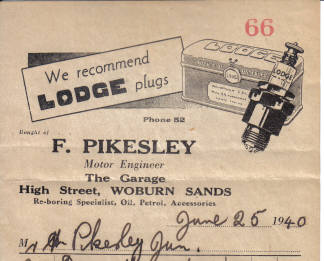
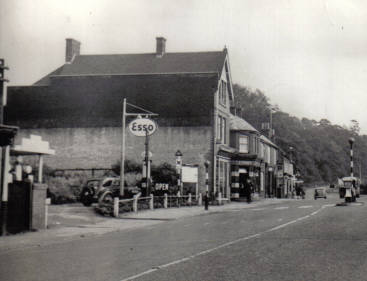
No. 19
In February 1889, John Giles, the local timber merchant, sold 102 feet of High Street frontage on the corner of Vicarage Street to George Dolton, the local bricklayer, for £300. Dolton built a block of four houses on 80 feet of this. He was the leading bricklayer of his time and much of his work in the main road stands as a memorial to him, especially the Methodist Church. No.19 went to Thomas Hudson, already spoken of as owner of No.1. No. 19 was for many years the newsagents and confectionery shop of Miss Collins, who was followed by her assistant, William Preston (1939) and it was later taken over by Frederick Pikesley as part of his garage. While running the garage, he had lived in the rear of the shop, which Miss Collins had as a lock-up. The Pikesley family sold up in the late 1960’s, but the new owners kept the name on. It was once Anstee and Lawson, the coal merchants, who moved up from No.67 in the late 1990’s. It now trades under the Pikesley name.
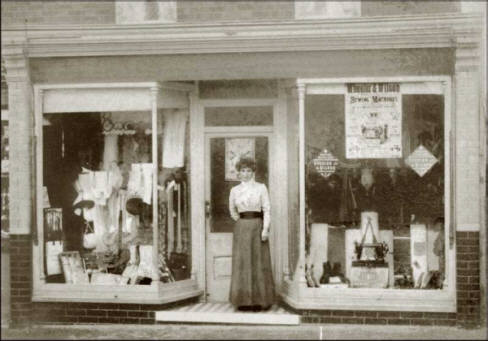
No. 21 This was taken by Joshua Emms the clockmaker and held for a long time. He first established his business in one of the cottages in Woburn Road beyond the Fir Tree, before purchasing no. 21 in 1892 (Price £325). He died in January 1909 leaving his son Henry and step-son to carry on as Emms & Dovey until they both passed on and it was only in 1949, after the death of Tom Emms that the family connection came to an end. Dolly Mills recalled – “Mr. Emms had a lovely jewellers shop. He was a watch and clock repairer and sold silver and glassware as well as jewellery. He always fascinated me when he put a small magnifying glass in his eye to inspect a watch etc. His daughter Primrose became Mrs. Cant of Downham Road.” Henry Emms committed suicide and his widow Ivy married a Mr. Cant. Primrose later went to live in Zimbabwe.
The business was taken over by John Bull & Co, the old-established county jewellers in Bedford, but they found the branch was not worth running against their Bedford business and after a few years sold to the Bletchley Co-Operative Society, who were the runners up when Bull had bought it at auction in 1949. But the Co-Op moved on and The Country Collection card and gift shop was there in 2000, and in the same trade, named Sweet Pea Cards and Gifts until 2012, when Eva’s clothing shop moved down from 1a. In 2013, an Italian cafe opened here, as Mama Concetta, which continued as Bailees and then La Maria which closed in late 2022.
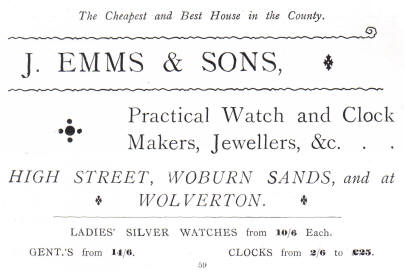
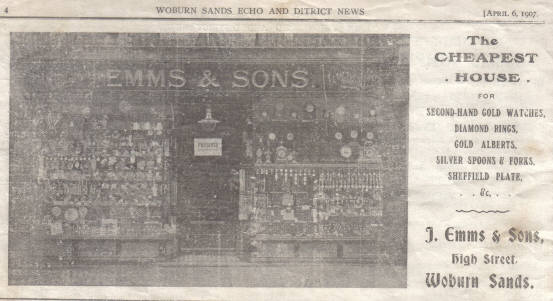
No. 23
William Hawkes, trade unknown, was there at the start in 1890, but by 1898 it was called Bon Marche, a drapery belonging to William Browne Toogood, who became a rural district councillor, and took a great interest in the Social Club. For a few years after his retirement the trade was kept going by Mr Proctor, Mr Ansell and others, after which this, too, became the property of the Co-Operative Society (1939). It has been the Jalori Indian Restaurant since 1994.
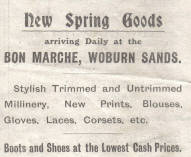
No. 25
This went to the grocery trade and was for some years in the hands of John Negus, until he was forced to give up for financial reasons, and after a period under George Turney, the property was taken over by Messrs Dudeney & Johnston of Bedford, then a family concern. It was they who put this and No.27 together. I recall this shop being a supermarket called Civil’s. It now forms part of the Co-op.
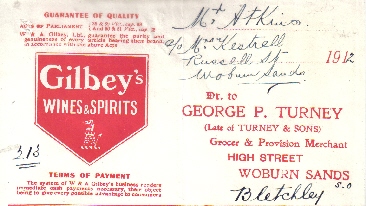
No. 27
George Tansley took this shop. He had for many years previously run his hardware shop in Cheapside, now known as Aspley Hill – one of our first tradesmen. George Dolton had evidently made a direct bargain with him before building on the corner site, because it is not quite in keeping with the others. After the death of George Tansley, the shop was carried on by his daughter, Teressa. Dolly Mills – “Miss Tansley had a china shop on the other corner of Vicarage Street, they also sold paraffin by the pint. Miss Tansley was a very heavy lady and the crockery etc used to rattle when she walked across the wood floor.” After her death in 1957, it was sold to John McHardy, a former police superintendent, who had not long since retired. He handed over the premises to his neighbours, Dudeney & Johnston, who combined it with No.25. It is now the Co-op.
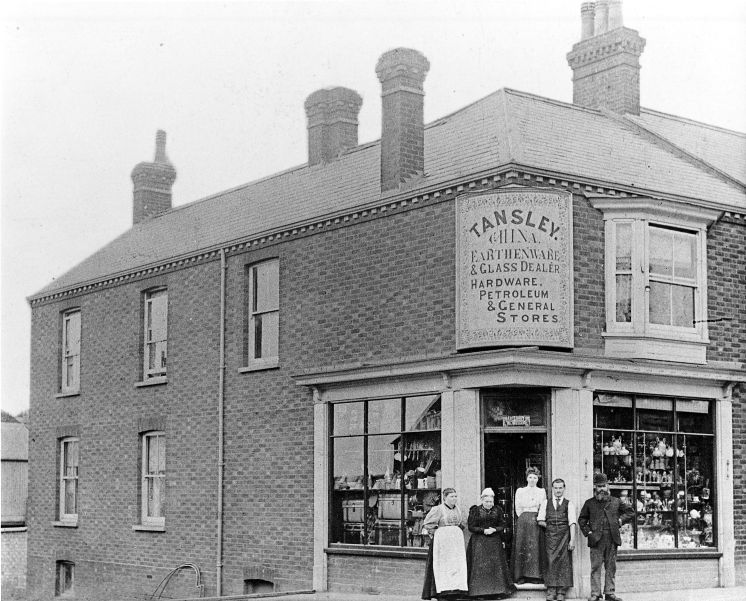
Next comes the entrance to Vicarage Street.
No. 29
When John Giles planned out Vicarage Street, he had already had a customer in John Pikesley, because in December 1888 he sold the corner plot, to Pikesley for £145 and he was described as “postmaster” in the sale. He was officially appointed to that job on 26th January 1888 but the original Post Office had been at no.1 Aspley Hill. This new Post Office was built in the summer of 1888, as he took a mortgage of £250 on it in September. John Pikesley was a carpenter and undertaker by trade and he carried on his undertaking business premises at the rear until ill-health forced him to give up and it passed to his nephew Edgar Smith, who transferred it to premises in Hardwick Place. Pikesley continued as Postmaster until another nephew, Alfred John Holmes, took over and continued until 1948, to be followed by Wallace Swain, from Bletchley then and others. Holmes’ sister, Alice, was for many years the Post Mistress nearby at Aspley Guise.
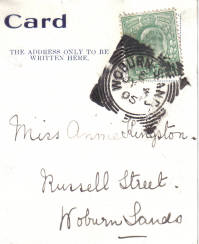
![]()
No. 31
However, Pikesley had only built on half of the plot he purchased and on the same day as he completed his purchase, he sold the other half to George Willison for £75. He had a confectionery business at Aspley Guise with a branch at Wolverton. Willison built his “Providence House” and a later owner, Mr Bathurst, told Arthur Parker there still remained marks of Willison’s religious character on the building. In the early 1900s Willison relinquished the business to become a missioner in Cumberland and for a few years it was held by Frederick Andrews, a baker, who gave up in 1904. In the early part of that year, Willison leased the shop to William John Horton, a chemist, who came up from No. 73. Horton & Bayes had a shop in Fenny Stratford and both were leading members of the Friends fraternity here. Mr Bayes married Mr Horton’s daughter in 1900. However, Horton did not hold the shop for long and at the beginning of November 1906, he sold his business and assigned the lease to Ernest William Bathurst, who came from Tewkesbury (the well-known boat-building family). After the first World War, Bathurst purchased the property, the frontage of which still carried the decoration of it’s early days in the 1970s. From his start on 1st November 1906, the business became the oldest in Woburn Sands to be run by the same family on the same premises. Ernest’s son, Eric Noel (always known as “Dick”) took over and he finally retired and left the district 70 years from the time his father first sold potions from Providence House. The “Prince of Wales” feathers design at the ends of their shopfront have been attributed to the story of a young Prince staying with friends locally in the 1930’s and buying his sweets there, but I have not been able to corroborate this! Dolly Mills – “Mr Bathurst’s chemist shop was a great help health-wise. When one could not afford to pay a doctor for advice, Mr Bathurst, a very kindly man, was always willing to listen and suggest something to help. His son Dick took over the business from his father until he too retired. They had two, if not three, enormous bottles of red and blue liquid in the windows.” It has remained a chemist ever since and was Rochmills in the 1970’s for some time before becoming Woburn Sands Pharmacy in about 2002. This closed in 2017, when the pharmacy moved down to No.47. In 2018, it opened as “No.31 – Tapas Bar & Kitchen”. This had several owners until changing hands in 2021 to become The Grapevine restaurant. Above it is The Ivory Wardrobe, a Bridal Boutique.
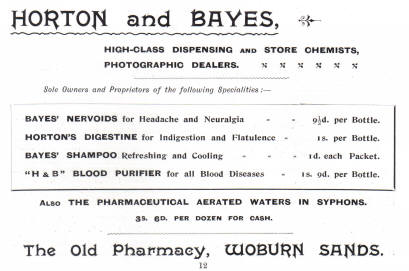
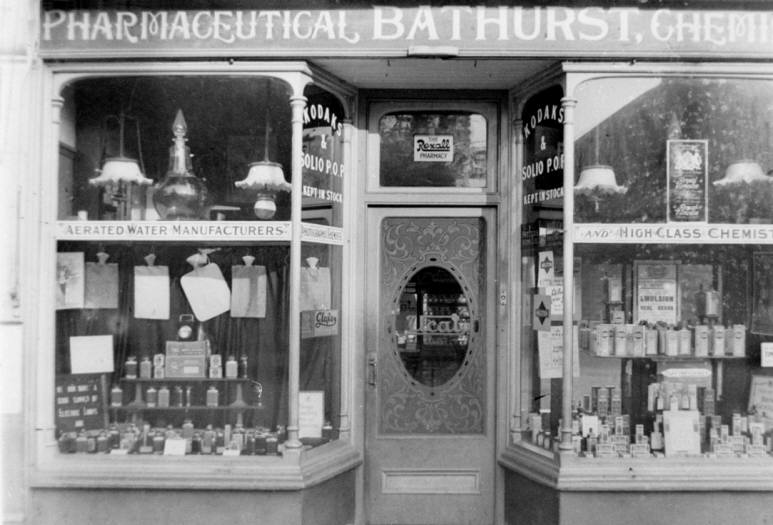
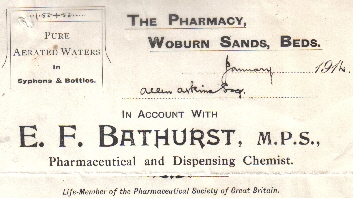
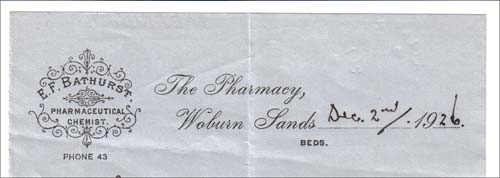
No. 33
This site and No.35 are on the first land of the old turnpike road to be sold out of the old Swan Farm. The first deed available, 16th May 1862, covers the sale by Thomas Higgins to Alfred Smith of 14 poles of land (1 pole = approx 25m squared) together with the cottages recently built and in the occupation of Mr Flude and Mr White, price £120. This indicates that Higgins had built the cottages; if so, it was the first time the family had done anything in the way of development, though they owned the 120 acres on which modern Woburn Sands stands. It is likely that Smith did the building as he was a horse dealer and property promoter, buying and selling all over the parish. In 1863 Smith sold them to Henry Summerford, the Salford carpenter, for £230 and the property remained in his family until 1876 when it was purchased by William Robinson, a commercial traveller of Kensington. In 1889, his widow sold to Willison (for £300) to link up with his Providence House property, No. 31. William Robinson was the father of Miss Robinson who lived in Russell Street and who taught at the local school for many years. She was an early president of the Women’s Institute and the first local lady parish-councillor. The cottages, however, did not survive and in 1906 they were pulled down to make way for two modern shops. No. 33 was taken by a young Charles Whitmee, who had not long married and come to Woburn Sands with his bride, to occupy the little thatched dairy shop which stood at the top of Hardwick Road. But Parker says Charlie soon tired of grocery – his heart was with cows and he returned to the dairy business, running it from Wood Street, but the grocery trade went on through Albert Dunkley. Dolly Mills – “Mrs Dunkley had a strong contralto voice and sang solos at various public functions.” A Mr. Nunn later had the same trade there and then Leonard Farr came from London in 1953 until 1972, when he retired to the Isle of Man. After 66 years, change came and the shop turned to the ladies’ outfitting business of “Averil B”. It has been a delicatessen under Fiona Chapman before becoming The Woburn Fort, an Indian Restaurant, in April 1992. This later rebranded as the Sands Brasserie, using a logo of the War Memorial opposite, but it closed in 2022.
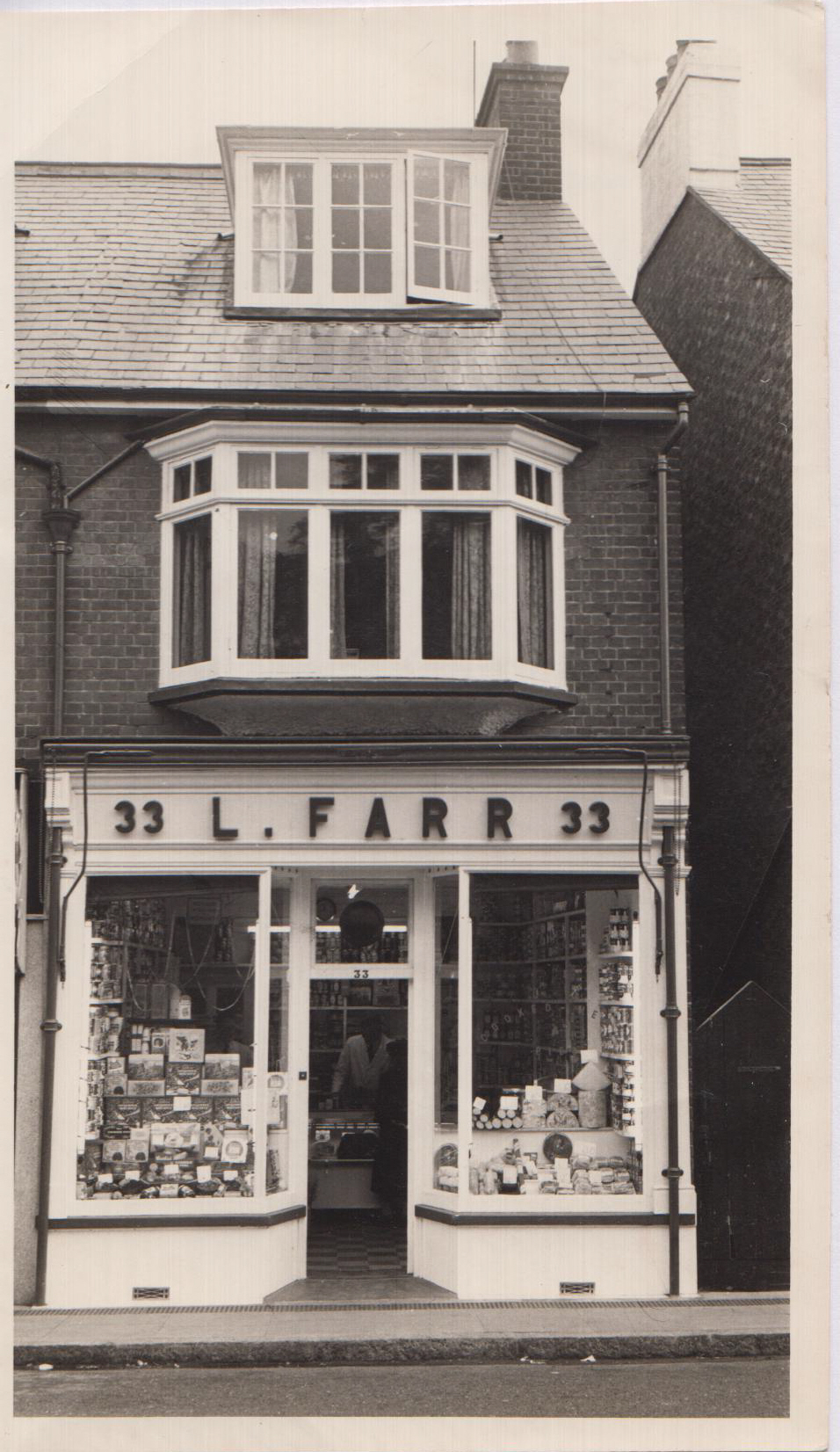
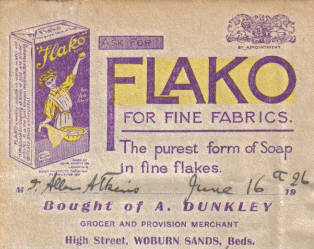
No. 35
Ellingham the hairdresser occupied No. 35, which still carried the trade when Ellingham left in 1920. It was taken by George Wesley, who had recently demobilised from the Canadian Scottish Regiment. He combined hairdressing with tobacco supplies. The enterprising Mr Wesley managed to negotiate with the authorities at Bletchley Park during World War II and opened a branch within the park in Hut 23, but due to towel shortages, customers had to provide their own! It was Chesneys Hair for about 10 years, they were there in 1998 and has been Eclipze Hairdressers since 2003.
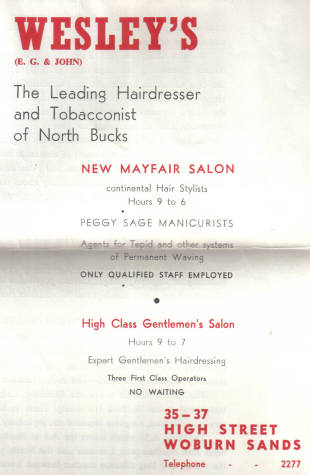
The next batch of buildings can all trace their history back to when this area was the site of The Red Lion Inn. This early coaching inn had ceased trading by about 1817. An auction of the buildings took place in 1881, and much of the detail below comes from the auction particulars.
No. 37
In 1840, this was John Brandone’s (see No.39 below), but in the auction particulars it is a separate house and shop, in the occupation of Mr Riches. Kelly’s 1885 directory quotes Robert Riches, bootmaker, and F. S. Moore in 1890, followed in 1903 by Mrs Eliza Moore, boots and millinery, but for about 50 years from 1920, it was in the hands of Mrs Wesley as a ladies hairdressers. Make-up and beauty salon specialists Bisbetica were there in the 1980’s. I am told this served as an antiques shop in the 1990’s. In the early 2000’s this was O’Jays Cafe, and was Cafe Blue from 2008 to 2012, when it become The Coffee House. In 2014, it was converted to Ali’s Kebab house then Pepper Grill.
No. 39
In 1840 this was John Brandone’s wheeler’s shop (with loft over) and in 1881 Edward Spring was the tenant, at £5 a year, which was high in comparison with the others. Spring was a carpenter and undertaker and lived in Chapel Street. Like the rest of the High Street properties, it was soon converted to business premises, with a shop added in front. For many years after the First War it was run as a ladies’ outfitters by Mrs Pleasant of Bedford and her sister, Christine Summerford, of Salford, who sold it to Mr Hall to be run in conjunction with No. 47. In 1969 the Beds Times divided the premises in two, using part as their local office, and letting the other, with the loft, as an antique shop, but then they were united again for Miss Vanessa Locker’s arts and craft shop. Divided into 39a & b once more, 39a was also the home of Mr Sandman menswear and Moon’n’Sixpence children’s wear, then recently Michael Waterton the tailor, Oakleigh Flooring and now Face-to-Face aging Clinic. It opened as Wonderment gifts in 2023. 39b was Scallywags children’s clothes then a gentleman’s clothes shop and is now Boston Barbers. The premises above the shop has been used as Felicity Hat Hire, who previously used 39a as well.
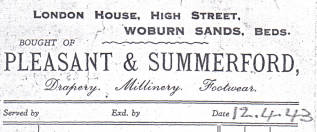
No. 41
This does not appear in old records, for it was only built in 1906 in the old Inn yard, so no buildings were pulled down to make way for it. It was the property of Henry Inwood, son of Charles, known as London House and there he diversified the family tailoring business to cover outfitting, on one side of the shop, and a travel agency on the other, with his son, another Charles, to help him. This Charles left Woburn Sands, as his son Claude suffered badly from asthma and the doctors said he must be taken away from the smoke of the local brick kilns, so he joined his brothers established auction business in Worthing soon after has father died and sold the Woburn Sands business to Mr George Pleasant in 1919, who already had an outfitting business in Mill Street, Bedford. George came each morning, accompanied by his wife, who ran the adjoining shop, No. 39. George was a member of a gambling school – who travelled daily between Bedford and Bletchley – and on many mornings the 9.05 would be held up to allow him to play his last trump!
It was later The Man’s Shop, under Cyril Matthews, before becoming The Bookshop under the late historian and Woburn Sands Councillor Paul White. It has been an outlet for HULA, the Aspley Guise charity for re-homing animals, since about 1999.
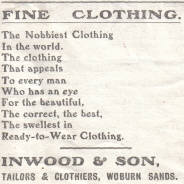
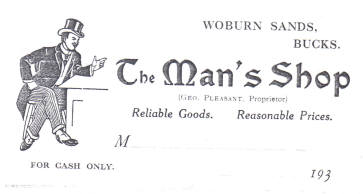
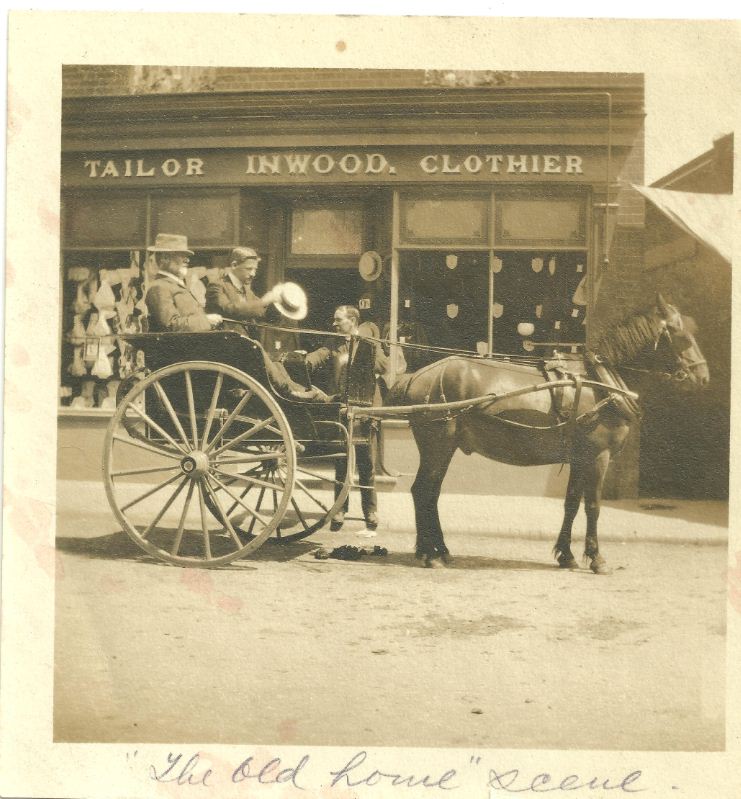
No. 43
This was the Red Lion Inn; Henry Inwood occupied it in 1881 and was probably there in 1871 but there is no record of the tenant between him and John Brandone, the wheelwright of 1840. Inwood evidently bought Lot 3 in the auction (and, later, part of the paddock at the rear) as it was from him that the Social Club bought their premises in 1920. It was probably Inwood who built the shop fronts out to the road, soon after the auction, and quite likely used the shop as an outlet for his tailoring before he built No. 41. Since that time the shop has seen many trades. During the First World War, Mrs Homans sold greengrocery, and Colour Sergeant Joe Burley of the Marines took over that business. Joe was the father of Eve White, for many years the organist at St. Michael’s and of Salford Church before that. Later it was Alfred Hutchings footwear shop and he was followed by Shortland who was already repairing shoes at No. 45. Then came Clarence West, who was confectionery and stationery, and he handed over the same trade to Mavis King when he moved down the road to take the W. H. Smith business. I have a 1950’s postcard showing the shopfront with the name David Wilson on, with “Stationer and Tobacco” on the signboard. It was Spotless Drycleaners and now continues under the same trade as Jeeves of Woburn.
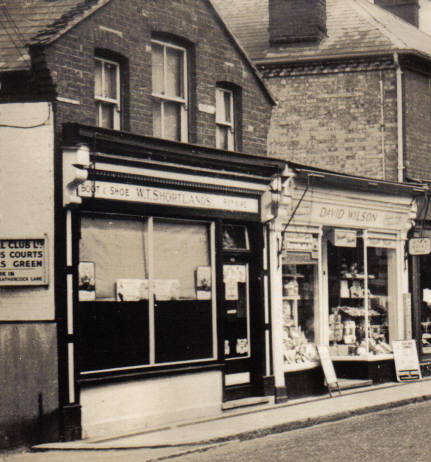
No. 45
The little corner shop was for many years in the hands of David Hammond the saddler; he is listed in 1903, and he was followed by Frederick Hammond, who lived across the road at the top of Chapel Street, and who died in 1928. He was followed by W. T. Shortland from Northampton, shoe repairing. William (Bill) Shortland owned three shops in the High Street, and was also Chief of the Woburn Sands Fire Service. I have a length of yellow ribbon, printed with “SHORTLAND’S for Shoes – Moccasins always in stock – Repairs a speciality – Leather & Grindery Stores – 43 & 45 HIGH STREET, Woburn Sands Bucks”. Ron Dancer took over from him in the shop, staying in shoe retail. Tim Fryer and Julie Pearce had the shop until became Hazel Austins Beauty Works. It was operated as a commercial dry cleaners in connection with Spotless next door, until 2012 when The Flower Boutique florists opened. They moved up the road to No.1 in 2018, when this became Mrs. Mac’s Sweet Treats, a cupcake shop.
Next is Club Lane, now just for pedestrians, which leads to the main shopping car park. This area was once home to the Woburn Sands Social Club, Tennis Club and Bowls Club until Green’s Hotel opened on the site. This was later converted to retirement homes.
No. 47
In 1840 the two premises were tenanted by John Heath and William Garrett, but we do not know which by which. The particulars of Lot 2 of the 1881 auction stated two substantial houses with outbuildings and frontage available for building. Newman, who was running a general stores from the house (in conjunction with his brothers shop at Ampthill) bought this lot, pulled down the old cottages and erected what was then the most imposing shop in High Street and there he established the drapery (and furniture) shop. He apparently suffered ill-health and died soon after, in his mid-forties; his widow moved into a villa in Russell Street, where the family lived until 1962. Newman was followed by Joseph Elliott, William Harrington, Herbert Hooper and J. P. King.
Dolly Mills – “Mr Hooper kept this shop. This was every kind of drapery – house linen, ladies clothes, dress materials by the yard, hats. Everything was priced at ‘something three farthings’ and one was given a strip of pins in change for the farthing. He always had a chair for customers to sit on.”
Newman’s daughter, Kate, for many years a teacher at Aspley Heath Primary School told Arthur Parker of her early life – how she walked from the shop to the farm in Hardwick Place to fetch the milk, over the footpath in the parson’s field, as Chapel Street had not then been made. Later the High Street frontage was divided longitudinally, the northern part going to Joseph Elliott with the drapery shop and the southern part to Henry Inwood with the Inn premises. For many years this was Robert Halls clothes shop. This was taken over in 1973, but the name Robert Hall stayed on. Tim Fryer – When I took over Robert Hall’s in 1973, Miss Hebbes worked for Mr Hall as secretary and during the two weeks that Sheila went to learn the ropes before taking over she was amused as every time there was a £10 note paid into the till, Miss Hebbes would take it to National Westminster bank next door by going through the door in the wall that linked the two premises. At that time we had keys to the front door of the bank and could enter a caged off area then get into the flat above the shop. When we took over the existing stock it only included six ladies dresses”. In 2003, Enjoy Holidays Travel Agent took the shop until it closed in 2012. After a long period vacant, the Woburn Sands Pharmacy moved here in 2017 from no.31.
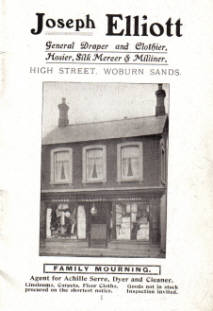
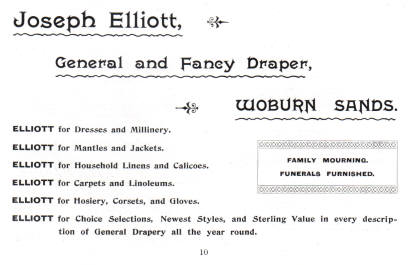
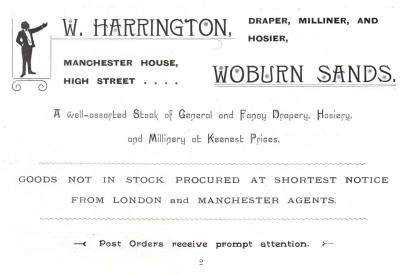
No. 49
At some time, the Westminster Bank had acquired the drapery shop (where they used a room on one day in the week before opening full time) and the land in rear, and in more recent times they took in part of the house at the side of the shop and extended the building over the garden at the side to completely fill up the frontage with the present bank premises. It was also home to the Woburn Sands Permanent Building Society in 1939.
Two staff connected to the bank were killed in World War II. Sergeant Harry William Mayne, No. 1176480, of the RAF Volunteer Reserve, died 19th August 1942, aged 30, and was buried at Eyeworth Churchyard, Bedfordshire. This was possibly a training accident. Flight Sergeant John Joseph O’Brien Heady, also of the RAF Volunteer Reserve, 153 Sqn., was killed 14th February 1945, when the Lancaster he was on board was shot down by a Ju88 over eastern Germany. A plaque in the Bank remembered them both.
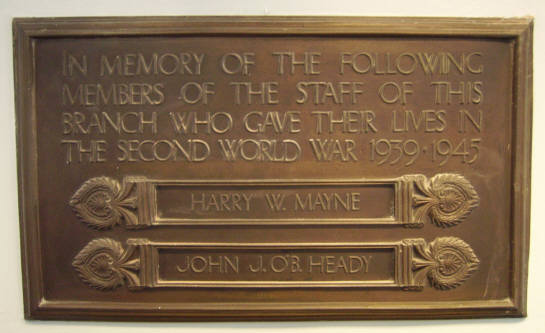
Natwest closed down in June 2017 [the plaque was moved to the Central Milton Keynes Branch] The Woburn Sands property remained empty until 2021, when ASK Opticians took it on, opening in early 2022.
No. 51
In 1840 this property was two cottages, and so it is in the 1881 auction particulars too, and it is so shown on the 1880 ordnance survey map, with a large building at the bottom of the garden. The auction particulars mention a granary over the workshop. The name John Giles is mentioned, so perhaps it was a timber merchants. The auction evidently aroused the interest of buyers; it is dated for August 24 but in the previous June the two cottages had been sold to George Spreckley, the tailor, for £245, and he held them until 1900 when he sold to the grocer, Frederick Wingrave at £400, and he held them as an investment. Wingrave sold the southern part which became No.51 in 1927, to Sidney Crawley, the butcher, who came up from No. 47 Station Road, and Crawley eventually sold to the Co-Operative Society. Dolly Mills – “Mr Crawley, the butchers shop. He was a typical butcher – a large man with a large tummy and always wore a blue striped apron and sometimes wore a boater hat. He had a daughter, Gwen, who at times helped in the shop. He also had a dog that sat in the doorway.” It was lately Pearces Bakery and from 2005 was Oliver Adams in the same trade. In 2019, The Whisk opened there, making pancakes and cocktails.
No. 53
Wingrave held on to this part of his building and continued his business there. Grocer continued under Mr Parker, who advertised as J & K Parker, florists in 1970. Then in the 1980’s, it was Del Marie, another grocers, who held it in conjunction with No.51. It was Gerrod Video rentals for several years and is now Kings Road clothes.
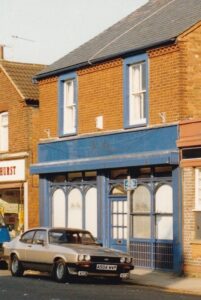
No. 55
Both the 1840 Tithe Apportionment and the auction particulars treat this and No.57 as one property, but the 1880 map clearly shows it as two cottages. Proof of the alterations and additions can be seen on close inspection of the buildings, as from the passage between Nos. 53 and 55, the outline of the old cottages can be traced in the brickwork, with a 12ft. addition on the front, to bring the shops up to the pavement, and attic storey added above. The property was held by the Boyes family until 1931.
In 1920 and into the late thirties it was held by Scrivener the cycle agent. He was captain of the Fire Brigade, and even had his own shop burnt out, after which it went to White Brothers, the nurserymen of Theydon Avenue, who ran it for fruit and vegetables, and it continued as such under Austin and Parker.
Mrs Cattell and her daughter ran it as a shoe shop at the end of the First World War, but it was soon taken over by the London Central Meat Co who were in due course absorbed by Eastmans Butchers. Dolly Mills – “Eastmans the butchers came next. Mr and Mrs Faulkener managed the shop, he as the Master Butcher and his wife was cashier in a small kiosk inside the shop.” I think Dewhursts took over Eastmans, and were there for quite a while. It is currently Age UK (having been Help the Aged) who have had the shop since 1994.
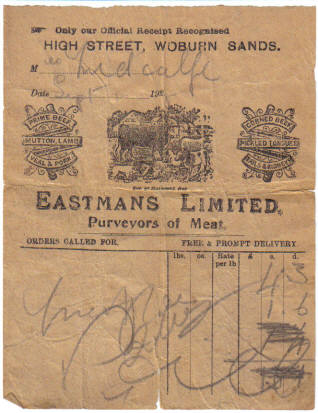
No. 57
This was for many years a stationers and newsagents, although early directories do not quote any stationers, and its first tenants may have been in other trades. First known was T. Oliver & Son. Soon after that time it was W. H. Smith & Sons, whose lending library attracted many people from the towns and villages around, who stopped to do the rest of their shopping here. In 1970 it was taken over by Clarence West. From there, it has been White’s, Forbouy’s and was a Martin’s, all in the same trade, until it closed in 2019. The shopfront finally reopened in late 2021 as Daisy Nails.
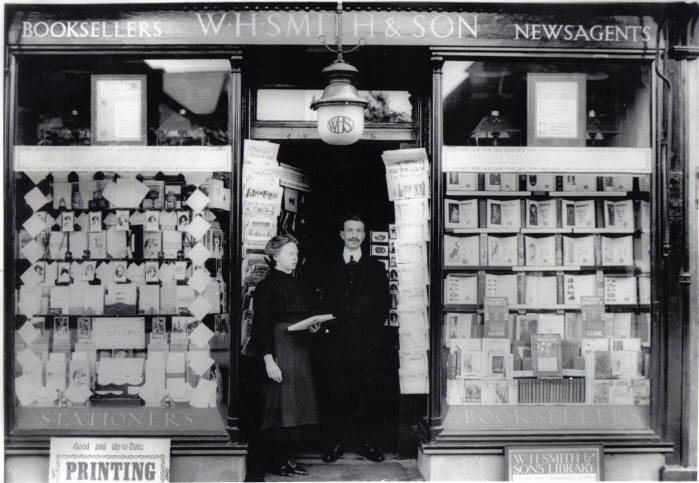
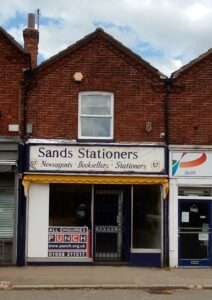
No. 59
The site of the next four shops was included in the purchase of the five-acre field by William Milligan in 1870, who planned out Russell Street, and he sold 60ft. of frontage to High Street to the local builder, Robert Jackson. In the centre of this frontage he built what must have been a substantial house, probably double-fronted. From the 1881 O.S. map it appears to cover an area of about 25ft by 20ft. It was first let to a Mrs Thomason. In 1885 he sold the property to Mrs Emma Boyes, wife of Arthur, and it must have been she who had the old house converted into two dwellings, No.61 and 63, and built on at each end, No. 59 and 65, and made additions forward to the road entirely filling up the frontage with four shops. The actual date of the alterations is not known, but it must have been in the early 1890’s.
The first trader at No.59 is not known, but in 1903 it was occupied by Arthur Boyes shoe shop, and though its occupants changed, the premises stuck to the shoe trade for nearly 85 years, making another local record. Charles Wagstaff came from Northampton, and was a exemplary shoe maker. He used to stand in his shop door and watch people walking passed, especially children, and tell their parents why their shoes were wearing in certain places! Later Miss Amy ran a shoe shop from here too. Bo-Kays florist was here in the 1980’s. It has been Doyles clothes shop since about 2005.
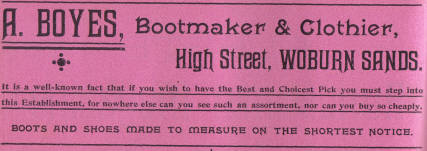
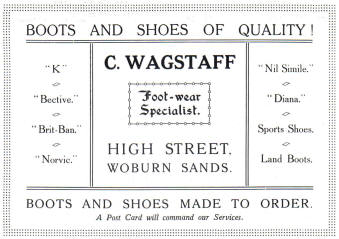
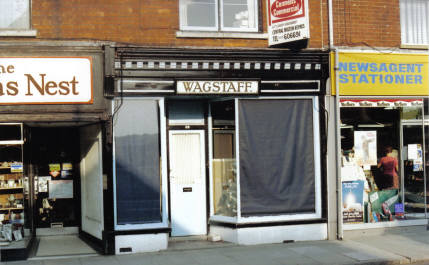
No. 61 In 1903,William Thomas Bane ran a drapery here, and it continued in drapery (Dolly Mills recalled a Mr Chapman being draper here too.) until 1931, when he retired to the Leys end of Theydon Avenue, and it was acquired by Cyril Hutton, to be our first electrical shop. Miss Hebbes worked for them, running the back office, and Miss Elizabeth Walter worked there too. She later became Mrs Gunter, marrying a soldier from 339 Co. Pioneer Corp., and emigrating to America in 1952. (Her father had worked as a barber for Wesleys.) Stan Puryer also worked for Huttons, and later took the shop on himself, being there 1964 – 1967. For a time, it was a china shop run by Shelia Kilpin and her sister. By 1998, it was Spooners restaurant, later becoming The Purple Goose, also a restaurant. In 2017, it became Giovanni’s Italian restaurant, who moved on in 2020 when the Ottoman Kitchen opened as a Turkish restaurant.
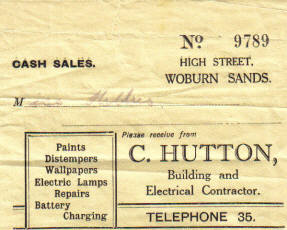
No. 63 Dudeney & Johnston, the Bedford grocers were here in 1903. They were first established down by the Weathercock, and so traded here for nearly one hundred years, the oldest firm with the same name, though in three different premises, and eventually had no connection with the Old Bedford families which started the business. Following them, the shop turned to catering, and as The Cosy Corner, it had many tenants, including Peter Grey and also David Rheidol Evens doing the refreshments, until Richard Albone came with fruit and vegetables in September 1970. Webbs was later the grocer there for many years, but since 2007 it has been Harrison Jewellers, who have four other branches in Beds and Bucks and who combined the premises with no.65 in 2017.
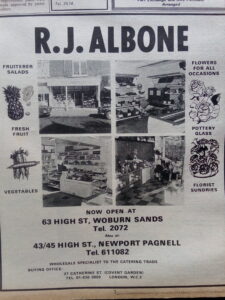
No. 65
Oliver Tansley, possibly a hairdresser, is the first recorded tenant in 1903. Since then, it has seen many tenants, but was a confectioners for many years, among them Arthur Tanton, the retired butler from Wavendon House and Jack Mitchelmore, who had retired from much further afield – the South African railways. All through the 1970s and into the ’80s it was an old-fashioned sweet shop, with row upon row of traditional sweetie jars on the shelves at the back and the largest counter of chocolate bars I have ever seen! Mr. & Mrs. A. H. Johnson had it first, they retired in May 1970, being replaced by Mr. & Mrs. Redford. By 1998, it was M. L. Bulmers, Opticians, before becoming Forbes Computers and was then The Knitting Hut for several years. It has now been knocked into one shop with No. 63 and is part of Harrisons Jewellers.
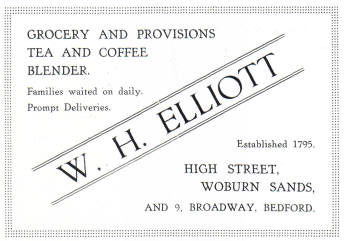
No. 67 The next block of five shops was also part of the field bought by William Milligan, and he sold the corner to Edward John Tyers, who also had a 30ft. plot at the rear fronting Russell Street. Tyers did not keep it long, and in August 1884 he sold it to Thomas Yirrell, the Leighton builder. A deed of 1898 speaks of “houses and shops recently built” by Yirrell in 1881. Yirrell took a mortgage in 1882. This suggests that No. 67 was soon converted to a shop for Wingrave, the grocer. Arthur Parker saw no positive proof of it, but was told No. 67 was for a short time occupied by a man named Jones who was not successful, and went to live in Wood Street. Some deeds also show these premises as in the hands of Benskin’s Brewery, but Parker’s search at their headquarters at Watford did not reveal any connection with these premises, and the deeds appear to be inaccurate. Wingrave was there until shortly before the 1914 war, when the shop was taken over by the newly-married son of the old-established Bedford grocer William H. Elliott, and he carried on until his retirement in late ’50’s Dolly Mills – “Mr Elliot, the High Class Grocer. The smell of ground coffee always reminds me of his shop as he had a large coffee grinding machine in his window, which he used constantly. It had a highly polished brass neck which shone to perfection. Mr Elliot was a very smart and business-like gentlemen.” Elliott employed Mr Hobley of Chapel Street to cycle around the village collecting orders that he delivered by cycle on Fridays. When he retired, the deliveries were taken over by Mr Harrison. Elliott let the shop to Mrs Gould, and later, Mrs Lewis. Tim Fryer – “My memories of Mrs Gould are that she always had a cigarette in her mouth while serving with the ash getting longer and longer”. The premises were later sold to Mr Norman Green, and opened as a betting office. It was a coal merchants under Anstee and Lawson from the mid 1960’s before they moved up to No. 19. It has now turned to ladies beauty treatments, firstly with The Cutting Company with Beauty Co. and now The Cutting Company alone.
No. 69 In 1880, it was occupied by a Mr Leask, but when the shop was established the tenant was George Henry Bissell. He was not only a Quaker but man of many parts, first listed as a stationer selling musical instruments (violins at 5/- a time), he finished as a butcher and fishmonger. On his death the premises were taken by the young Emma Turney, daughter of the corn merchant; she married Erasmus Dovey, the watchmaker, and remained in the shop after his death, and until, as a nonagenarian, she no longer capable. Shortland took over her business. Dolly Mills – “Mrs Dovey who sold wool and needlework requirements. She would only sell you the exact amount of wool, in skeins, necessary to complete the garment. She and Mrs Popple were sisters and they always had a stall at church fetes etc. selling a great variety of needlework and knitted and crochet articles all made by them.” In 1961 after Bill Shortland it became J & B Fryer until 1976. Later it was Rene Marshall, calling it Victoria R. It has now been thrown together with No.67 and is also part of The Cutting Company.
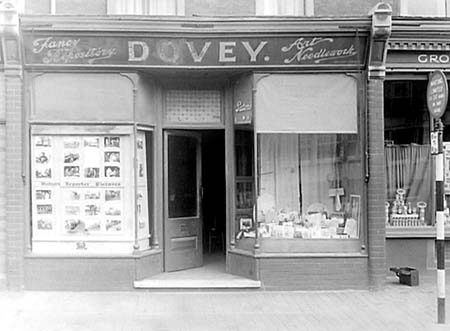
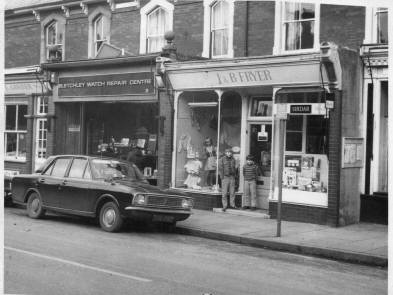
No.71 – Here is a puzzle; the deeds say that in 1880 the tenant was Clarke and it was a private house, but John Clarke was a printer, and sold pianos! Later the tenant was Collins, a tailor, and he was followed by Miss Piggott in drapery. Then Ernest Stockton took over the trade. Dolly Mills – “Mr Stockton, draper. He always wore a butterfly winged hard collar. He dealt mostly in ladies clothes, many of which hung from the ceiling.” He was followed by Willie Wynn (part owner) in radio and electronics. He soon moved to Flitwick and the shop went to the cycle trade under Leslie Blanshard and Harrison; then to Mrs Medcalf in 1961 for toys and her husband, an electrician. In 1970, it was the Bletchley Watch Repair Centre, before becoming Andrew Charles, jewellers, and became Haskells the jeweller, on 1st April 1991. This lasted until 2014, when it became a branch of Lily T, selling shoes, handbags and purses, who also had a shop in Olney. In 2017, it became Spectrum Recruitment Ltd until 2021. The Social Pottery then opened an outlet here, allowing customers to book pottery decorating experiences.
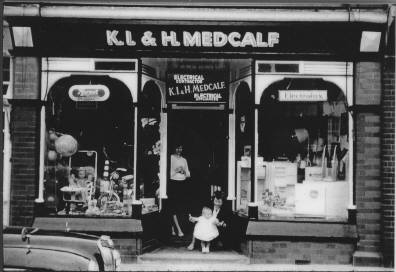
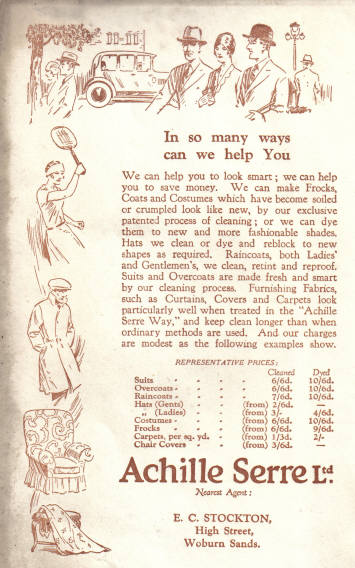
No. 73 – This appears to have started life in the Chemist’s trade, for Arthur Samm was there in 1894, followed by Horton (another Quaker) who moved up to No. 31 in 1904. Soon after, Fred Down fitted out the shop as a fishmongers for Joseph Wooding who came from Northampton. Dolly Mills – “Mr Wooding’s fish shop was next. They had an enormous ice box. The ice was brought into the shop in large blocks handled with sacks and what looked like very large pincers. Fish and sausages came every day by train and Mr Wooding’s sons fetched them from the railway station.” In the late 60’s early 70’s it was run by Tom Gander, then as “Gander’s” under A. P. Watson. It has been fish and poultry until very recently under Brian Norgett, then John Janes who added butchery to the shop. It stood empty for a couple of years before it became the Aubergine delicatessen and café in 2007.
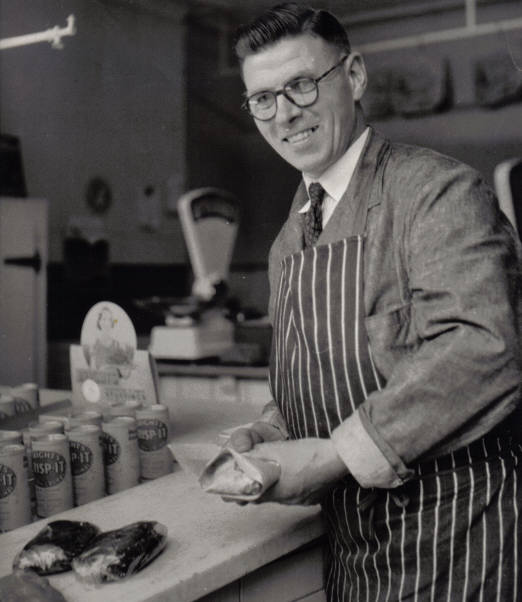
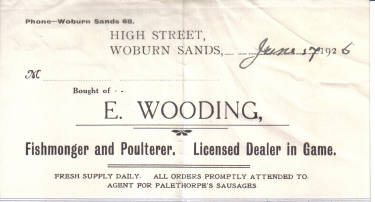
No. 75
This shop has stuck to its trade, for it has always been an ironmongers. The first occupant was William Needham, who was advertising his ironmongery in Woburn Sands in 1887. He later joined his landlord Frederick Down, on the other side of Russell Street, at the Eagle Malting, and dealt in hard and soft drinks. I believe that Needham used his experience to bottle the drinks and sell ginger beer etc locally George Popple was the tenant in 1892 and remained there until his end in 1949, when a wonderful collection of unsold Victorian goods was discovered (and dust-covered). Parker said that he frequently he asked his customers to call again another day, as what they wanted was down in the cellar, or in an outside store and he could just not be bothered to fetch it! Dolly Mills – “Mr Popple, the ironmonger was at the corner of Russell Street. He often stood at the entrance to the shop and I am told at one time he wore a bowler hat, although I never saw him wear one. He was always reluctant to sell his goods.” Parker says the old-established Woburn firm of Gibson Andrews then bought the business and ran it until “Jack” retired to become a yachtsman, sailing his craft on Poole Harbour. Though he sold the business, the name of Gibson Andrews remains on the fascia today. The current occupants have had the shop for about 30 years and have kept the interior as original as possible.
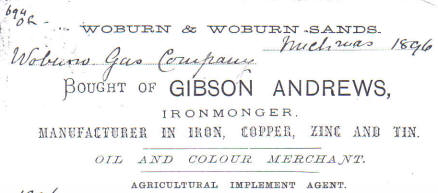
Next comes the entrance to Russell Street.
No.1
Although technically Station Road, I have including this shop here, as it is th elast commercial premises before residential buildings start. The elder Down brother, Henry, had died in 1891, and the younger Down, Frederick, went into partnership with William Needham. A whole page about Down and Needham can be found elsewhere on this website. The ornate facade was there in 1893, as it is commented on in The North Bucks Times, but this has long since gone, and the building has been extended at the front to what you see today. The malting hall behind has been converted to houses.
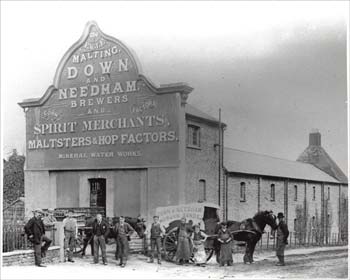
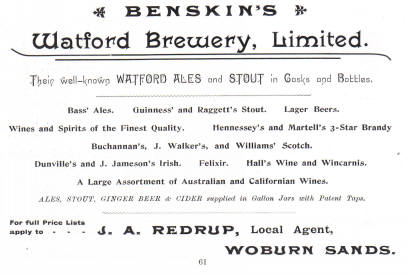
Down and Needham sold it in 1898, to concentrate on a mineral water works they had opened in Bedford. It was then an outlet for Benskins Brewery, Watford. It has been many types of off-licence since, including a Victoria Wine for many years, then Wine Rack and is now T. J. Wines.
High Street, West Side
With a pub and other public buildings, there is very little evidence of any street numbers being used this side of the High Street until much further down. Most of these buildings have more detailed histories written up on their own pages on this site.
The Swan is the first building on the west of the High Street. There is a page about this inn on this website, so I won’t cover the whole of it’s history here; it was originally a farm owned by the Hart family, which I expect brewed beer for their many farm workers. You can imagine how this may develop into selling beer to other thirsty locals! When the Bucks Register of Alehouses started in 1753, it was known as “The Coach and Horses” which is a far more acceptable name for an inn on a toll road, but in 1809 they switched to “The Swan” for reasons unknown. The farm lands that went with it covered most of Woburn Sands. In the days when most of their customers would not have had their own transport, where the carpark is now was a bowling green, one of the finest in the district I am told. There were some outbuildings and barns after that which were later pulled down.
The Ellen Pettit Memorial Hall was built in 1928 by her husband, a year after the death of the said lady. Alfred Pettit lived at Croylands in Aspley Heath. From Arthur Parkers work: “Older readers may remember the name of ‘Pettit’s of Kensington’, the High Street store which was eventually absorbed by John Barker. Alfred Pettit came of a North Bucks farming family and came here on (or possibly before) his retirement. He loved his garden and his horse – he was often seen riding through Woburn Sands. He did not take a great interest in local affairs, but was a Churchwarden between 1915 and 1923. He was also a director of the original Golf Club, and when the old company wound up and handed over to the new (a body of more up-to-date playing members) it was at Croylands that the directors had their meetings, being treated to sumptuous teas by his house-keeper.” The hall was run by St. Michael’s, but there were problems in getting enough letting rent in to cover the annual costs. In 1935, a kitchen was added at the side. In 1970 it was sold by the church to Newport Pagnell Rural District Council, and later transferred to Woburn Sands Council. Woburn Sands Town Council now use offices at the rear of the building.
Fenton House is now home to several financial businesses, was once the Vicarage for Woburn Sands. But it had a worthy history even before that. It can be traced back to the Denison family, once Lords of the Manor of Wavendon. The Rev’d William Denison, who had married the daughter of the Rector of Aspley Guise, and he bought the original Swan Farm from the Hart family in 1820 and pulled down some buildings to erect a new residence for himself, calling it Fenton House. His son, William Henry, inherited it. He was born in 1811, and was Church Warden at Wavendon by the age of 30. He did much to look after and better the lot for Woburn Sands residents, including starting a school in buildings by the side of The Swan. However, he tried to sell it at least once, as this report from the Northampton Mercury of 15th September 1838 shows:
“FENTON HOUSE, WOBURN SANDS, in the Parish of WAVENDON .Bucks. FOR SALE BY AUCTION, J. S. DEVEY, At the George Hotel, Woburn, on Friday the 21st day of September, 1838, at Four o’clock the Afternoon. THE MANSION called FENTON HOUSE, and Premises, at Woburn Sands, in the Parish of Wavendon, Bucks, adjoining the Manchester Road, within two miles of the town Woburn, Beds, and forty-four from London. The House is substantially built, and comprises entrance hall, small study, 14ft. by 8ft. 6; breakfast and dining rooms, each, 9ft. 9, by 15ft. 9, and 12ft. high; well-fitted butler’s pantry, kitchen, larder, dairy, and cellarage, drawing-room, 20ft. by 17ft. and 11ft. 6in. high; four good lofty bed-rooms, and three dressing-rooms, two servants rooms, linen and store closets, &c. Attached are scullery, with engine-force-pump and excellent water, well-fitted brewhouse, roomy laundry, and washhouse, 4-stall stable, and loose box, double coach house, & co. The Garden and Ground adjoining, contain Two Acres more or less. The Property is Freehold. It is situate a good neighbourhood, within a short distance of the Oakley and Grafton Hounds, about four miles distant from the Railway Station at Denbigh Hall, and about six miles from the intended great Station at Wolverton. Possession of the Premises may be had Lady Day next. May be viewed on application to Mr. Yardley. the present occupier, and further information may be obtained at the Offices of Mr. Green, Solicitor, Woburn; Messrs. Keene. & Wright, Solicitors, 16, Furnival’s Inn, London; Mr. Shouler, Wavendon; and of the Auctioneer, Woburn.”
When St Michaels opened in 1868, Denison moved to Hardwick House on what is now Mowbray Green, so Fenton House could become the Vicarage. He became the churchwarden for St. Michael’s, and maintained the position for 22 years until he died, in church, on June 8th 1890. Fenton House was used as the Vicarage until about 1970, when it transferred to business use. It was up for sale in 2020 at £1.2m, eventually being taken on by Hoban Skips as an office in 2023.
Here is the entrance to Shelton Court, built on some of the gardens to Fenton House. They are sheltered, retirement and supported housing units, named after John Shelton, vicar of Woburn Sands, 1913 – 1946.
The next feature along is the War Memorial. It had originally stood in The Square, but frequent traffic accidents led to it being moved by fork lift truck to this site in 1972. The complete history the War Memorial is available elsewhere on this site.
The Institute or to give it the full name, “The Literary and Scientific Institute Hall”, was opened after public fundraising in 1872. Buried in one of the walls is a bottle containing the following information: “This Room was erected by voluntary subscription the first brick was laid for the Revd. Hay Montague Erskine then the resident Minister of the New Church, Aspley Guise Heath, on the 9th day of May 1874. Second brick by Mr C. Inwood, third brick by Mr C. Claridge, fourth brick by Mr John Price; then immediately the workmen commenced brickwork. This document is a memorandum of this building and built in the north angle wall of the building. The architect Mr Thomas Roberts, Trentham, the clerk of works Mr J. Price of Woburn, the contractor Mr Samuel Foster, Kempston, Bedford; the works committee the Revd H. M. Erskine, Messrs Henry Down, Frederick William Down, Alfred Smith, Charles Inwood, George Claridge James Pikesley and John Collins, all residents of Woburn Sands. The amount of contract not including furniture and warming apparatus was £607; the building to be finished in four calendar months from 1st May 1874. The ground on which this building was erected was the free gift, to the trustees of the Revd. Hay Montague Erskine, the patron of this useful institution. The address of the Revd Mr Erskine on laying the first brick is enclosed within this glass bottle, which, if at a future time discovered, will be read of some interest. This is the first and only building erected on the west side of the public road from the Parsonage house to the Nursery Ground the opposite the lane turn to Aspley Guise, commonly called Weathercock Lane.” After 140 years of events, sports and special occasions, it was converted to use as Woburn Sands Library when use of the Friends Meeting House stopped. This building also has its own page on this website with further details.
Here is the entrance to Chapel Street.
Methodist Church.
A building in Hardwick Road had been used since the early 1800’s, but in 1879 they were able to build their own church with school rooms attached in the High Street. It’s history was written up by Rev. T. Dale, which is available eleswhere on this website. During the Second World War the church premises were widely used, due to the requisitioning of the Institute, by local organisations such as the W.I., the county library, the Nursing Association, the allotment holders and the Guides. In 1942 the Bucks County Council requisitioned a classroom for blanket storage and the Ministry of Works claimed the railings. In the April a canteen was opened for H.M. Forces and in the first year they used 556 loaves to make 11,000 sandwiches, and sold 40,000 mugs of tea, 8,000 buns, 12,000 pastries and cakes and 400 large cakes.
No. 6 Finally, numbered addresses make an appearance. I think this was once known as Epworth Villa, the home of the minister for the Methodist Church. Currently the premises of Beasley and Partners Estate Agents and Alan Smeath & Co., Solicitors.
No. 8-10 The land on which these houses were built had been purchased at an auction sale in 1877 by John Monday of Fenny Stratford, who developed Chapel Street. He was prominent in the movement to build the Methodist Church, and a trustee of it. The Trustees had decided to bid for the land, fixing their limit of price, but Munday evidently took the matter out of their hands and bought in his own name; but sold off, for £110, what they wanted for chapel and manse, retaining the rest, and then sold the plots adjoining. Parker thought the pair next the manse were erected by the builder of the Chapel, Robert Jackson, as it was from his family that Bowler bought the property in 1918. Originally a pair of double-fronted, semi-detached houses, they were sold to Barclays Bank by Thomas Bowler, the builder, who lived there, with Mrs Sanders as his neighbour. She was the mother of Harry Saunders who ran the Swan.
For many years both Barclays and the London, County and Westminster Banks had attended at a room in Woburn Sands on one day each week, the staff coming from Leighton Buzzard, but with increasing business full-time branches were demanded. Barclays had already bought a plot on the Swan Field frontage, opposite The Swan, on which to build a bank, but in 1928, when they were offered these houses they decided to consider them.
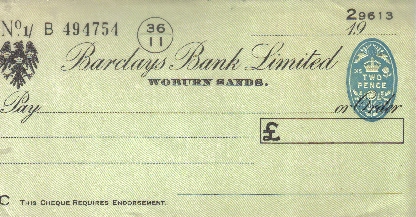
They were averse to opening on the side of the road opposite to other business premises, their opinion being that their customers treated their banking transactions as a very private matter, and would not want to be seen crossing the road every time they paid the Bank a visit! However, after an inspection by Mr Anthony Tuke (then a junior director at Luton, and before the days of his command in Lombard Street) the directors decided to purchase it, and the premises were converted into a bank with a manager’s house, but in the early days the office occupied much less space than it does to-day; indeed many alterations have been made over the years. Barclays announced it would be closed in April 2023. DB Surveys used to have rooms upstairs.
No.12 This is currently being used as a Thames Valley Police office, but I cannot recall what it was before.
As well as Arthur Parker’s work, my grateful thanks to:
Guin Parker, for her memories,
Stephen Mills, for allowing me to use the work of his late mother, Dolly Mills,
Tim Fryer, for his memories and some photos,
The late Wendy Ball, for her memories.
If you have any memories of owning, working in, or using these shops, or any memorabilia from them, please let me know.
Page last updated Jan. 2023.
